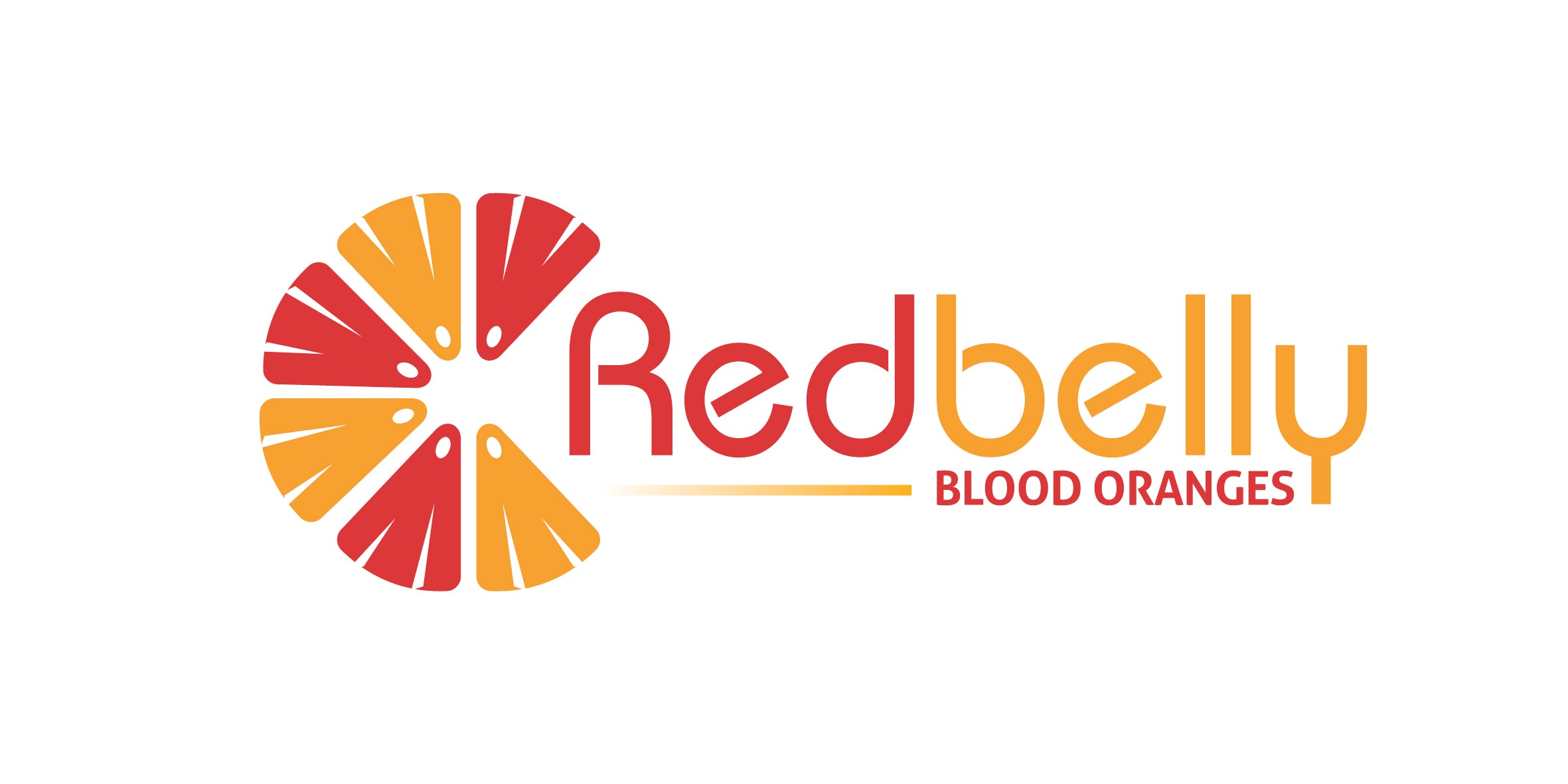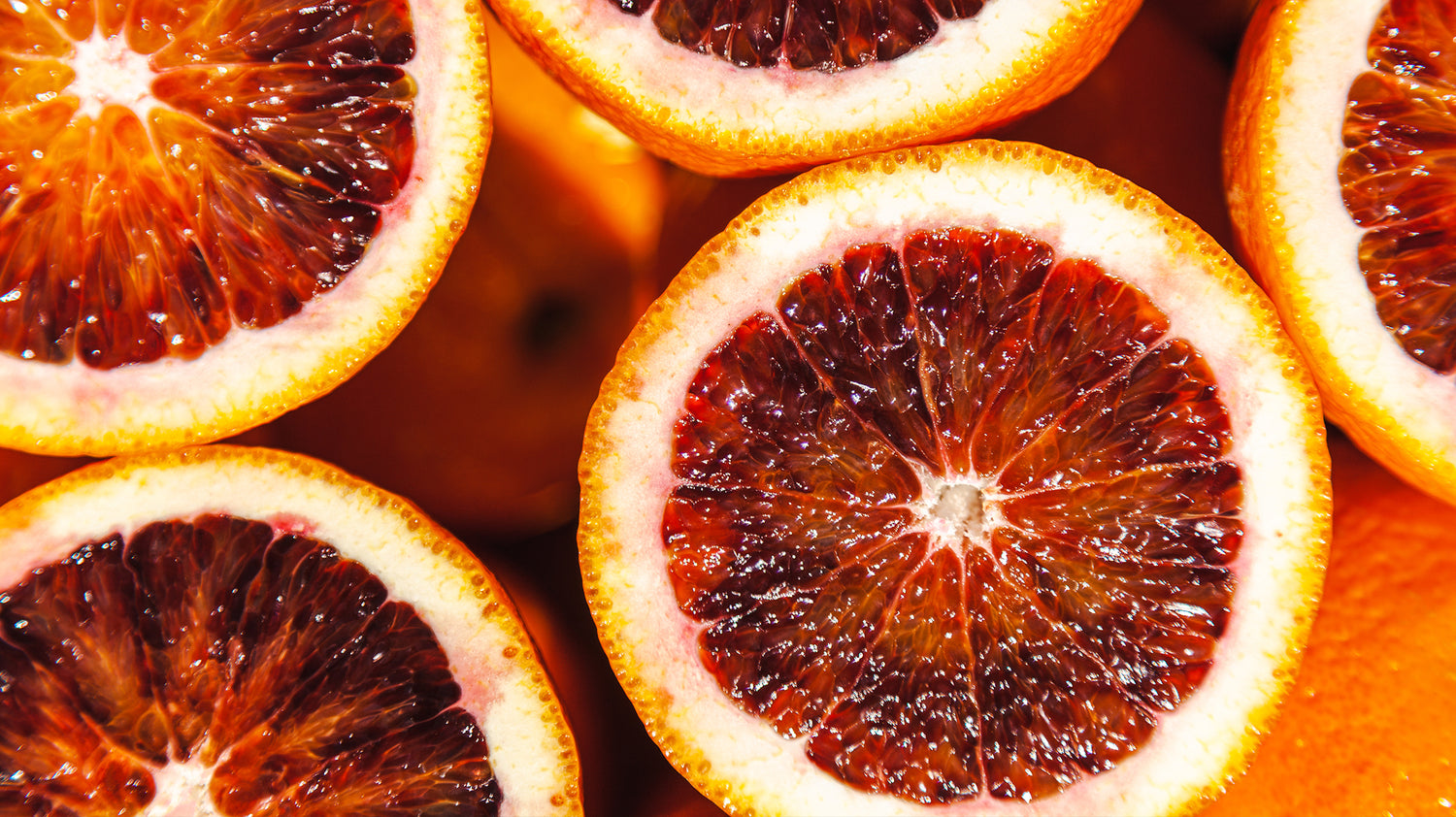Collapsible content

What is VitaminRED?
VitaminRED®, is what we call the complex group of plant nutrients contained in blood oranges. Beneath their captivating allure lies a treasure trove of health-promoting nutrients and protective powers that are simply unmatched. Step into a world where taste meets wellness and experience the remarkable benefits of blood oranges like never before.
What sets blood oranges apart is their vibrant crimson-red hue, a testament to the presence of anthocyanins. These potent compounds, typically associated with blueberries, cherries, and red wine, are found exclusively in blood oranges among commercially available citrus fruits. By incorporating anthocyanins into your diet through VitaminRED®, you can unleash a multitude of health advantages.
But the benefits don't stop there. Blood oranges also boast a plethora of other essential phytonutrients called phenolics, commonly known as polyphenols. These remarkable compounds have been scientifically linked to enhanced cardiovascular health, shielding your body against the harmful effects of UV light, pollution, and smoking. Moreover, they have shown tremendous potential in combating metabolic diseases such as type 2 diabetes, fatty liver, and obesity.
CLICK HERE For A Discussion Of Research Into The Health Benefits Of Blood Oranges And VitaminRED®


Redbelly Citrus have conducted analysis of its blood oranges via HPCL analysis and can report the following information about the constitients of VitaminRED and the Rebelly Blood Oranges that they are derived from.

HPCL analysis has shown that there are in fact 7 distinct species of anthocyanin molecules in VitaminRED® as demonstrated in the graph obtained via HPLC analysis where the following anthocyanins are represented in the following proportions:

So whilst cyanidin 3-glucoside is the predominant anthocyanin molecule present in Redbelly Blood Oranges, it is by no means the only important member of this potent family of polyphenols. Many of the other anthocyanin species are also found in fruits such as blackberries, raspberries, blueberries, cherries and pomegranates.

The HPLC analysis was also able to identify a number of other important polyphenol compounds including flavonoids and cinnamic acids as set out below.

Many of the phenolic compounds above are traditionally obtained via eating citrus fruits including lemons and oranges and are incredibly good for you. These blonde citrus fruits do not contain the anthocyanins and cinnamic acids highlighted above.
It is the complex set of both these citrus flavanoids and the anthocyanins and cinnamic acids more commonly found in berries that make blood oranges and VitaminRED® an incredible synergistic nutrient and health promoter. You get the health benefits of berries and citrus fruits in the one convenient and inexpensive package.
Health Benefits of Blood Oranges
Anntioxidant Superfoods
Unlock the nutritional power of blood oranges and discover the remarkable differences that set them apart from more familiar navel and valencia varieties. The data presented below unveils a striking contrast, showcasing the unique nutritional profile of blood oranges due to the unique mixture of components in VitaminRED®.
Research has demonstrated that blood oranges possess an extraordinary capacity for scavenging free radicals when compared to navel and valencia varieties, surpassing them by an impressive 9.5 times and 6 times, respectively. This remarkable antioxidant prowess is a testament to the exceptional health benefits of blood oranges and the potent components in VitaminRED®.
But that's not all. The data further reveals that blood oranges and VitaminRED® contain significantly higher levels of polyphenols, another group of vital nutrients, when compared to navel and valencia varieties. In fact, blood oranges boast polyphenol concentrations that are 3.2 times greater than navel oranges and 2.4 times higher than valencia oranges. These findings highlight the unique and powerful combination of nutrients found within blood oranges, providing a solid foundation for improved well-being.

Other Health Benefits of Blood Oranges
The multifaceted health benefits of VitaminRed® derived from blood oranges, extend far beyond its renowned antioxidant effects. Indeed research has been conducted to indicate that many of the health benefits documented below are not due to the antioxidant effect alone. These other effects include anti-inflammatory, anticarcinogenic, and metabolic effects, providing robust protection against cancer cell growth, diabetes, obesity, and risk factors associated with heart disease.
The table below presents a comprehensive overview of the various health benefits associated with VitaminRED® and its constituent compounds:

The anti-inflammatory effects of the VitaminRED® compounds found in blood oranges, such as anthocyanins and polyphenols, have shown promise in mitigating inflammation-related disorders. These compounds exert their influence by modulating key inflammatory pathways, thus reducing the risk of chronic inflammation and associated health conditions.
Regarding anticarcinogenic properties, blood oranges contain a diverse array of bioactive compounds, including anthocyanins, limonoids, polyphenols, and vitamin C, which collectively exhibit potent chemoprotective effects. These compounds have been shown to impede cancer cell growth, induce apoptosis (cell death), and inhibit the formation of carcinogenic compounds.
Studies have also indicated that the consumption of blood oranges and their bioactive constituents can contribute to diabetes prevention and management. The synergistic action of anthocyanins, polyphenols, fiber, and vitamin C helps regulate blood sugar levels, improve insulin sensitivity, and mitigate the risk of developing type 2 diabetes.
In the realm of obesity management, blood oranges offer a powerful combination of anthocyanins, polyphenols, and dietary fiber. These compounds aid in weight management by promoting satiety, enhancing metabolism, and reducing the absorption of dietary fats.
Furthermore, the remarkable cardiovascular protection provided by blood oranges stems from their high content of anthocyanins, polyphenols, vitamin C, fiber, and potassium. These compounds work together to support healthy blood pressure, reduce oxidative stress, improve endothelial function, and enhance overall heart health.
Metabolic Syndrome, WeightManagement & Obesity
Metabolic syndrome, characterized by abdominal obesity, high glucose and cholesterol levels, and high blood pressure, poses significant risks for type 2 diabetes and heart disease. A study investigating the effects of consuming 750ml of red orange juice over 8 weeks on metabolic syndrome risk factors yielded compelling results. Participants experienced improved insulin resistance, lower cholesterol levels, and reduced systolic blood pressure. Notably, despite an increase in total calorie and carbohydrate intake per day by 344 calories and 86 grams of sugar respectively, there was no weight gain observed. This study revealed that daily consumption of blood orange juice not only improves metabolic risk factors but also does not promote weight gain (9).
In a ground breaking 2010 study, blood orange juice was found to influence the function of fat cells, rendering them less likely to be stored as fat. Mice were divided into groups, with one group receiving a standard diet supplemented with water, blood orange juice, or navel (blonde) orange juice, and the other group receiving a high-fat diet along with one of the three drink options. Surprisingly, mice consuming blood orange juice alongside a standard diet gained less weight and exhibited no adverse effects on blood sugar and lipid levels compared to those drinking navel juice or water. This was noteworthy, considering the increased calorie intake resulting from the juice's sugar content. Furthermore, blood orange juice significantly reduced or nearly abolished weight gain in mice on a high-fat diet, with a remarkable 50% reduction in belly fat mass recorded (10).
A follow-up study in 2012 further explored the effects of blood orange juice on mice fed a high-fat diet or a standard diet. Each group was subdivided into those receiving water or blood orange juice. Body weight and various biomarkers, including liver and metabolic enzymes, were assessed. Initially, all mice had similar body weights. However, after 12 weeks, mice on a high-fat diet supplemented with blood orange juice had the same body weights as those on a standard diet and water, despite the additional 10% of calories attributed to the juice's sugar content. Intriguingly, mice receiving blood orange juice exhibited lower cholesterol and triglyceride levels and enhanced insulin sensitivity. In contrast, mice on a high-fat diet and water showed evidence of steatosis, a marker of fatty liver disease.
Based on the findings that blood orange juice can reverse metabolic abnormalities in obese mice, researchers concluded that it may represent a promising dietary option for preventing metabolic syndrome, including fatty liver. The results call for further clinical trials to validate these effects in humans (11).
While animal studies offer promising insights, it is important to note that results may not always translate similarly in humans. In a 2015 clinical study involving overweight human subjects over a 12-week period, the effects of a standardized blood orange extract called Morosil® were evaluated. The study demonstrated that blood orange extract can significantly reduce weight, BMI, and hip circumference compared to a placebo. Participants received a daily dose of 400mg of Morosil®, which is approximately equivalent to the hydroxycinnamic acids and anthocyanins found in one blood orange per day (12). This effect was repeated in a 2022 study in which body mass, BMI, fat mass and fat distribution were all significantly better in the group treated with the blood orange extract (23).
In conclusion, the research indicates the potential of blood orange and its extract in improving metabolic health, managing weight, and reducing the risk factors associated with metabolic syndrome. However, further studies, particularly clinical trials, are needed to fully understand and validate these effects in humans
Heart Health
A comprehensive understanding of the potential benefits of blood oranges in promoting heart health emerges from several studies. In a 2017 report published in the American Journal of Clinical Nutrition, a study involving 43,880 healthy men investigated the habitual intake of anthocyanin-rich foods, including blood oranges, and its association with the risk of heart disease. The study revealed that the bioactive compounds present in citrus and red or blue fruits, such as blood oranges, have the potential to reduce vascular inflammation, thereby promoting smooth blood flow to the heart. This finding suggests a potential benefit for protecting against cardiovascular disease. However, further trials are needed to determine the exact dosage required for optimal results (13).
In a 2012 study involving 19 non-diabetic patients with increased cardiovascular risks and 12 healthy, non-obese control subjects, a randomized double-blind study was conducted. The treatment group received 500ml of blood orange juice daily. After just 7 days, significant improvements in blood flow were observed, normalizing the blood flow patterns. Additionally, several inflammatory biomarkers, including C-reactive protein, exhibited significant decreases. These findings indicate that blood oranges have an anti-inflammatory effect that is beneficial to the cardiovascular system of patients (14).
Furthermore, a study conducted in 2011 suggests that dietary intake of anthocyanins, such as those found in blood orange juice, may help protect against high blood pressure, a major risk factor for heart disease. The study recommends an intake of approximately 12.5 to 15 mg per day of anthocyanins in blood orange juice to contribute positively to the reduction of hypertension (15).
A further study in 2019 also found that consumption of a blood orange juice drink twice daily resulted in an improvement in endothelial function as measured by blood vessel dilation and reduction of blood pressure (21).
The cumulative findings from these studies support the potential of blood oranges to promote heart health and warrant further exploration in larger clinical trials to fully ascertain their benefits.
Skin Spots and Sun Damage
The skin serves as our body's primary defense against a multitude of chemical and physical assaults, including pollution, cigarette smoke, and ultraviolet (UV) rays from the sun. In a 2014 study, the skin's photo-protective and anti-aging effects were evaluated through the administration of 100mg of a standardized red orange extract. This dosage equated to approximately 3mg of anthocyanins and 2mg of hydroxycinnamic acids, alongside other beneficial components. The results demonstrated a significant reduction in skin erythema (redness), with an average decrease of 40%. The study's second part also revealed remarkable protective effects, as skin age spot pigmentation decreased from 27% to 7% during the period of red orange extract supplementation when subjects were exposed to a solar lamp. These experiments collectively demonstrated that blood orange extract could counteract the detrimental effects of UV radiation, akin to a natural sunscreen (16).
These findings underscore the potential of blood orange extract to protect the skin from UV-induced damage and oxidative stress caused by the sun. By harnessing the unique blend of bioactive compounds within blood oranges, this extract exhibits photo-protective and antioxidant properties that contribute to healthier, more resilient skin.
Modern Ailments and Other Diseases
Gastric Ulcers
A study published by the University of Rome has suggested that the treatment and prevention of gastric ulcers may benefit from taking a standarised extract of blood oranges which was used in many of the studies listed above. The researchers found that the healing of induced ulcers in a rodent animal model was accelerated by repeated administration of the blood orange extract. It was also found that exposure to the blood orange extract also prevented the development of gastric lesions by a significant extent. This study points to the possibility of using blood orange extracts to treat and even prevent gastric ulcers in humans (20)
Smoking and Traffic Polution
Several pathological conditions have all been associated with a higher release of atmospheric pollutants and smoking. A study was conducted on smoking and non-smoking traffic police officers who regularly stood in traffic pollution for many hours a day. A standardised extract of blood orange was provided to them regularly after their blood work was initially taken. After 1 month of administration the SH levels measured in traffic officers were restored to the normal levels seen in controls and SCE frequency, a measure of DNA damage, was reduced in both smokers and non-smoking police officers. (19)
Breast Cancer
Blood oranges have been recently shown to be of potential benefit to patients suffering trastuzamab-reistant breast cancer in both invitro and invivo tests conducted in mice models. Mice treated with anthocyanins extracted from blood oranges showed approximately 70% reduction in tumour volume compared to controls. Experiments conducted in vitro established that the anthocyanins induced apoptosis in resistant cells and supressed the migration of these cells.(22)
References
- Eat for Health. Australian Dietary Guidelines. Commonwealth of Australia 2013. https://www.eatforhealth.gov.au/foodessentials/how-much-do-we-need-each-day
- Red Orange: Experimental Models and Epidemiological Evidence of Its Benefits on Human Health. Giuseppe Grosso, Fabio Galvano et.al. Oxidative Medicine and Cellular Longevity. Volume 2013.
- Bioactive compounds in blood oranges (Citrus sinensis (L.) Osbeck): Level and intake. Biagio Fallico, Gabriele Ballistreri et.al. Food Chemistry 215, 2017; 67–75
- Supercritical carbon dioxide-treated blood orange juice as a new product in the fresh fruit juice market, Simona Fabroni, Margherita Amenta et. al. Innovative Food Science and Emerging Technologies 11, 2010: 477–484
- Chemical composition of blood orange varieties from Turkey: A comparative study, Kafkas Ebru et.al. Pharmacognosy Magazine Vol 5, Issue 20, Oct-Dec, 2009; 329-335
- The Health Benefits of Citrus Fruits, Katrine Baghurst, CSIRO Health Sciences & Nutrition, 2003, Published and distributed by: Horticultural Australia Ltd.
- International Tables of Glycemic Index and Glycemic Load Values: 2008. Atkinson FS, Foster-Powell K, Brand-Miller JC. Diabetes Care, 2008; 31(12).
7A. Antioxidant Effectiveness As Influenced by Phenolic Content of Fresh Orange Juices; Rapisardi, P, Tomaino, Antonio, Lo Cascio, Rossella, Bonina, Francesco, De Pasquale, Anna, Saija, Antonella, J. Agric. Food Chem. 1999, 47, 4718−4723
- Supercritical carbon dioxide-treated blood orange juice as a new product in the fresh fruit juice market. Simona Fabroni, Margherita Amenta et.al. Innovative Food Science and Emerging Technologies. Vol 11, 2010: 477–484 [433]
- Red-fleshed sweet orange juice improves the risk factors for metabolic syndrome. Silveira JQ1, Dourado GK1, Cesar TB1. International Journal of Food Science and Nutrition. 2015;66(7):830
- Blood orange juice inhibits fat accumulation in mice. Titta L et.al. International Journal Obesity. 2010 Mar; 34(3):578-88. Download Paper Here
- Moro Orange juice prevents fatty liver in mice. Salamone F, et al. World Journal of Gastroenterol. 18, 2012: 3862-3868.Download Paper Here
- Clinical evaluation of Moro (Citrus sinensis (L.) Osbeck) orange juice supplementation for the weight management. Venera Cardile. Natural Product Research, 2015. 13. Chemical Characterization by Liquid Chromotography of Moro Blood Orange Juices, Lee, H.S., Carter, S.M., Barros, S.M., Dezman, D.J, Castle, W.S., Journal of Food Composition and Analysis 3, 9-19 (1990)
- Effects of red orange juice intake on endothelial function and inflammatory markers in adult subjects with increased cardiovascular risk. S. Buscemi, G. Rosafio, et al. The American Journal of Clinical Nutrition 2012. Vol. 95, no. 5:1089–1095.
- Habitual intake of flavonoid subclasses and incident hypertension in adults. Cassidy, A et.al The American Journal of Clinical Nutrition. 2011 93(2), 338–347.
- Protective effect of red orange extract supplementation against UV-induced skin damages: photoaging and solar lentigines. Puglia C et.al. Dermatol. 2014 Jun;13(2):151-7. Download Paper Here
- In vitro antioxidant activity and in vivo photoprotective effect of a red orange extract, Bonina F et.al. International Journal of Cosmetic Science 20, 1998, 331–342. Download Paper Here
- Antioxidant activity of pasteurized and sterilized commercial red orange juices; Alberto Fiore, Luca La Fauci, Rinaldo Cervellati, Maria Clelia Guerra, Ester Speroni, Stefano Costa, Giacomo Galvano, Antonino De Lorenzo, Vanessa Bacchelli, Vincenzo Fogliano and Fabio Galvano; Mol. Nutr. Food Res. 2005, 49, 1129–1135
- Protective effects of a standardised red orange extract on air pollution-induced oxidative damage in traffic police officers. Bonina FP, Puglia C, Frasca G, Cimino F, Trombetta D, Tringali G, Roccazzello A, Insiriello E, Rapisarda P, Saija A. Nat Prod Res. 2008;22(17):1544-51.Download Paper Here
- Antiulcer potential of a standardised extract of red orange juice in the rat. Vitali, F., Saija., A., Artico, M., Tita, B., Franchitto, S., International Journal of Food Properties, 10, 331-344,2007
- Blood Orange Juice Consumption Increases Flow Mediated Dilation in Adults with Overweight and Obesity: A Randomised Controlled Trial. Li, Lyall, Martinez-Blazquez, Vallejo, Tomas-Barberan, Birch, Boesch. Journal of Nutrition 2020 Sep 1;150(9):2287-2294. doi: 10.1093/jn/nxaa158
- Anthocyanins inhibit trastuzumab-resistant breast cancer in vitro and in vivo. Li, Xu, Tang, Liu, Yu, Wang, Liu. Molecular Medicine Reports 13, 4007-4013, 2016.
- Effectiveness of Moro Blood Orange Citrus Sinensis Osbeck (Rutaceae) Standardised Extract on Weight Loss in Overweight but Otherwise Healthy Men and Women – A Randomised Double Blind Placebo Controlled Study. Briskey, Malfa, Rao, Nutrients, 2022, 14, 427

